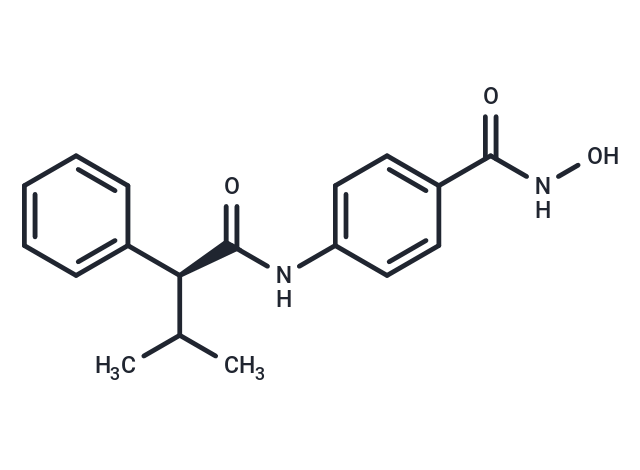Shopping Cart
- Remove All
 Your shopping cart is currently empty
Your shopping cart is currently empty

AR42 (OSU-HDAC42) is an HDAC inhibitor (IC50: 30 nM).

| Pack Size | Price | Availability | Quantity |
|---|---|---|---|
| 1 mg | $34 | In Stock | |
| 5 mg | $77 | In Stock | |
| 10 mg | $129 | In Stock | |
| 25 mg | $263 | In Stock | |
| 50 mg | $428 | In Stock | |
| 100 mg | $653 | In Stock | |
| 200 mg | $916 | In Stock | |
| 1 mL x 10 mM (in DMSO) | $85 | In Stock |
| Description | AR42 (OSU-HDAC42) is an HDAC inhibitor (IC50: 30 nM). |
| Targets&IC50 | HDAC:30 nM |
| In vitro | AR-42 induces p21WAF/CIP1 overexpression and histone hyperacetylation and inhibits the growth of DU-145 cells (IC50 of 0.11 μM) [1]. AR-42 is effective in suppressing the proliferation of PC-3 and U87 mg cells, in part, because of its ability to down-regulate Akt signaling [2]. AR-42 inhibits the growth of PC-3 (IC50: 0.48 μM) and LNCaP (IC50: 0.3 μM) cells. Compared to SAHA, AR-42 has markedly superior apoptogenic potency and causes obviously greater decreases in Bcl-xL, phospho-Akt, and survivin in PC-3 cells [3]. in malignant mast cell lines, AR-42 induces growth inhibition, cell- cycle arrest, apoptosis, and activation of caspases-3/7. AR-42 down-regulates the expression of p-Akt, total Akt, phosphorylated STAT3/5 (pSTAT3/5), and total STAT3/5 [6]. AR-42 effectively inhibits the growth of Raji, JeKo-1, and 697 cells (IC50<0.61 μM). AR-42 also sensitizes CLL cells to TNF-Related Apoptosis-Inducing Ligand (TRAIL), potentially through reduction of c-FLIP [7]. AR-42 also induces autophagy through downregulation of Akt/mTOR signaling and inducing ER stress in HCC cells. |
| In vivo | The growth of PC-3 tumor xenografts is suppressed by 52% and 67% after treatment with AR-42 (25/50 mg/kg), respectively, whereas SAHA (50 mg/kg) suppresses growth by 31%. In contrast to mice treated with SAHA, intratumoral levels of Bcl-xL and pAkt are markedly reduced in AR-42 treated mice. [3] In the transgenic adenocarcinoma of the mouse prostate (TRAMP) model, AR-42 not only decreases the severity of prostatic intraepithelial neoplasia (PIN) and completely prevents its progression to poorly differentiated carcinoma, but also shifts tumorigenesis to a more differentiated phenotype, suppressing absolute (86%) and relative (85%) urogenital tract weights. [5] AR-42 markedly reduces leukocyte counts and prolongs survival in three separate mouse models of B-cell malignancy without toxicity. |
| Kinase Assay | In vitro HDAC assay:HDAC activity is analyzed by using an HDAC assay kit. This assay is based on the ability of DU-145 nuclear extract, which is rich in HDAC activity, to mediate the deacetylation of the biotinylated [3H]-acetyl histone H4 peptide that is bound to streptavidin agarose beads. The release of [3H]-acetate into the supernatant is measured to calculate the HDAC activity. Sodium butyrate (0.25-1 mM) is used as a positive control. |
| Cell Research | Concentrations: Dissolved in DMSO,final concentrations ~2.5 μM. Method: DU-145 Cells are exposed to various concentrations of AR-42 for 96 hours.The medium is removed and replaced by 150 μL of 0.5 mg/mL of MTT in RPMI 1640 medium,and the cells are incubated in the CO2 incubator at 37 °C for 2 hours.Supernatants are removed from the wells,and the reduced MTT dye is solubilized with 200 μL/well of DMSO.Absorbance is determined on a plate reader at 570 nm. |
| Animal Research | Animal Models: Intact male NCr athymic nude mice inoculated s.c.with PC-3 cells. Formulation: Formulated in methylcellulose/Tween 80. Dosages: ~50 mg/kg/day. Administration: p.o. |
| Alias | OSU-HDAC42, HDAC-42, AR-42, AR 42 |
| Molecular Weight | 312.36 |
| Formula | C18H20N2O3 |
| Cas No. | 935881-37-1 |
| Smiles | CC(C)[C@H](C(=O)Nc1ccc(cc1)C(=O)NO)c1ccccc1 |
| Relative Density. | 1.223 g/cm3 |
| Storage | Powder: -20°C for 3 years | In solvent: -80°C for 1 year | Shipping with blue ice. | |||||||||||||||||||||||||||||||||||
| Solubility Information | Ethanol: 59 mg/mL (188.9 mM) H2O: < 1 mg/mL (insoluble or slightly soluble) DMSO: 59 mg/mL (188.9 mM) | |||||||||||||||||||||||||||||||||||
Solution Preparation Table | ||||||||||||||||||||||||||||||||||||
Ethanol/DMSO
| ||||||||||||||||||||||||||||||||||||

Copyright © 2015-2024 TargetMol Chemicals Inc. All Rights Reserved.